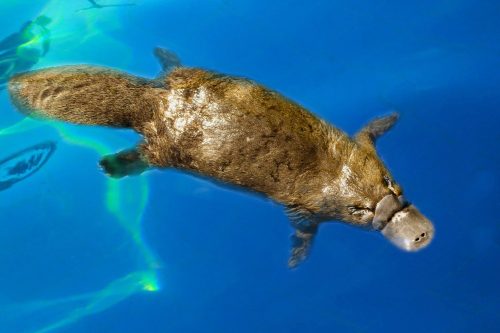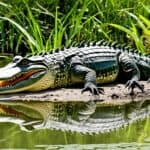The platypus is a member of the order of molluscivores despite the fact that it is a carnivore. It feeds on invertebrates like annelid worms and insect larvae, as well as freshwater shrimp and yabbies, which are crustaceans that look like a cross between crayfish and lobsters.
This species is known to feed on adult insects as well as freshwater shrimp, and there is some evidence to suggest that it may also consume the occasional small frog. Other prey items include shrimp. The platypus does not have any teeth. However, in place of teeth, they have two grinding plates and ridges on both the upper and lower jaws, which they use to “chew” their food.
Freshwater yabby is the primary component of the platypus’ diet when it is kept in captivity. In addition, due to the species’ high sensitivity to changes, the environments in which they are kept in captivity need to be closely monitored.
What is the diet of platypus?
Platypuses are carnivorous, which means that they do not consume any plant-based foods in their diet. In the water where they live, they engage in hunting for their food.
According to the Australian Museum, while foraging underwater, these animals actually close their eyes, ears, and nostrils. Instead, they use their sensitive bills to find food along the muddy bottom of the river, stream, pond, or lake they are swimming in.
When platypuses come across something of interest, such as an insect larva, they will collect it in their bills, then bring it up to the surface to store it in their cheek pouches. In addition to shrimp, swimming beetles, water bugs, and tadpoles, these animals will also eat the occasional worm, freshwater pea mussel, or snail.
Other prey items include shrimp. According to the Australian Museum, platypuses have even been seen eating cicadas and moths that they catch at the surface of the water.
Platypuses float on the surface of the water after emerging from their dives, and while doing so, they grind their food with “grinding plates” in their mouths. According to the Australian Platypus Conservatory, the animals will sometimes pick up mud and sand in their cheek pouches, and as they eat, they will expel this inedible sediment, along with excess water, through grooves in their lower jaws. This process occurs while the animals are feeding.
How Much Food Does a Platypus need to eat?
Platypuses are unique creatures that have a diet unlike any other mammal in the world. They primarily feed on small prey such as shrimp, insect larvae, and worms. However, they can also consume small amounts of frogs, fish, and crayfish.
They also use their webbed feet to stir up the mud and uncover buried prey. Platypuses are able to store fat in their tails which allows them to survive long periods without food when necessary.
On average, platypuses eat around 20-30% of their body weight each day. This means that a healthy adult platypus would eat around 200-300 grams of food each day.
However, this can vary depending on the season and availability of prey in their environment. In general, though, platypuses do not require large amounts of food to stay healthy and active.
How does a platypus eat?
These mammals get their food from the soil. They use their bills to scoop up bottom-dwelling invertebrates and larvae, mollusks, worms, and shellfish, along with sand, gravel, and mud particles.
All of this material is kept in pouches in the cheeks, and it is mashed up at the surface for consumption. Platypuses lack teeth, so the bits of gravel help them “chew” their food in the same way that teeth would.
Did platypus ever have a stomach?
To put it another way, the platypus does not have a stomach. The stomach, which can be defined as a part of the digestive tract that produces acid, first appeared approximately 450 million years ago.
This organ, which is only found in animals with backbones (vertebrates), is made up of a skeleton. The platypus and the spiny echidnas, which are the closest relatives of the platypus, don’t have this structure in their bodies.
So while the platypus may not have had an external stomach historically, it has adapted to live without one by developing other organs and structures that help it break down and digest food.
How does a platypus digest food if it doesn’t have a stomach?
Platypuses lack stomachs but do have intestines in their digestive systems. It would appear that all of their digestion takes place there. In their intestines, they most likely have enzymes that are responsible for protein digestion.
Why the Platypus Will Never Have a Stomach
The platypus is a unique and remarkable creature, but it will never have a stomach.
This is because the platypus does not need one. It has a digestive system that works in a very different way than most other mammals. Its diet consists mostly of small invertebrates like worms and insect larvae, which it grinds up in its gizzard-like ‘stomach’ before passing them through its intestines for further digestion.
The platypus does not need to process food as extensively as other animals do and thus does not require the same level of gastric acid or enzymes as mammals do. Its intestines are also much shorter than those of other animals with stomachs since they don’t need to break down large chunks of food.
All these evolutionary adaptations mean that the platypus will never have a stomach like other mammals, but that doesn’t make it any less fascinating!
How do platypuses digest food without a stomach that creates acid?
The platypus is an unusual animal because it digests its food without having a stomach that creates acid. Instead, the platypus has an organ called the gastric mill which contains bacteria and protozoa to break down its food.
This organ secretes enzymes that help to break down proteins and carbohydrates into smaller molecules.
The platypus then absorbs these nutrients through its intestines. It also has several glands located in its intestine that produce alkaline juices to neutralize any acid present in the food being digested.
Additionally, the platypus has a large caecum which helps to further digest plant material by breaking it down into particles small enough for absorption by the body.
This combination of organs allows the platypus to efficiently digest its food without needing a stomach capable of producing acid.
Why did platypus lose their stomach?
To be able to digest the proteins that are present in their food. It’s possible that the ancestors of stomachless species switched to a different diet, rendering these enzymes useless in their new environment. They suffered from debilitating mutations over the course of time, which led to their eventual extinction.
Cym is a gene that is used by many newborn mammals to digest the proteins in their mother’s milk. However, the Cym gene that we have is inactive because our mother’s milk contains a relatively low concentration of proteins.
Pepsinogens thrive in acidic environments; therefore, if they are no longer present, there is no longer a requirement for an acidic chamber. If gastric pumps weren’t needed to keep the acidity of the stomach at a certain level, they would eventually stop working because they use a lot of energy.
This is all just speculation; let me offer another thought that makes sense. Some animals consume a large amount of shellfish and corals, both of which are rich sources of calcium carbonate, which is a substance that helps to neutralize the acid that is produced in the stomach.
When they consume a significant amount of muck, bottom-feeding fish such as wrasses end up with mouthfuls of the same size. Each of these species is consuming antacids in large quantities.
Some animals are able to function quite normally despite lacking a stomach. Many alternative approaches could be taken. Proteins are broken down by the body’s own enzymes, which are found in the intestine. Some species of fish have an additional set of teeth in their throats, which aid in the digestion of food that they swallow.
According to Wilson, “there is the potential for a shift of function to other areas of the gut.” It doesn’t matter which way you turn, you’ll always find examples of organisms that manage just fine without a stomach. They are not isolated occurrences; rather, they are quite typical.
Do Platypus Hibernate Like Otters?
Platypus and otters have different hibernation patterns. While otters do go into a deep winter slumber known as otter hibernation, platypus do not. Platypus are semi-aquatic mammals that remain active all year round, staying active in the water during the colder months. That’s why otter hibernation facts don’t apply to platypus.
How Does A Platypus Feed It’s Young?
The platypus is a semi-aquatic mammal that feeds its young with a unique method. It has no teeth, but rather has a bill that it uses to forage in the water and on land. It captures food with its bill, which then moves to the stomach, where digestion begins.
The platypus also has a milk gland located between its legs which produces milk for its young. When the baby platypuses are born, they must immediately climb onto their mother’s back and feed from the milk gland until they are old enough to forage on their own.
The young platypus will remain close to its mother as it learns to find food using its bill in both aquatic and terrestrial locations. After several weeks of foraging, the baby platypus can survive without its mother’s assistance and begin leading an independent life.







